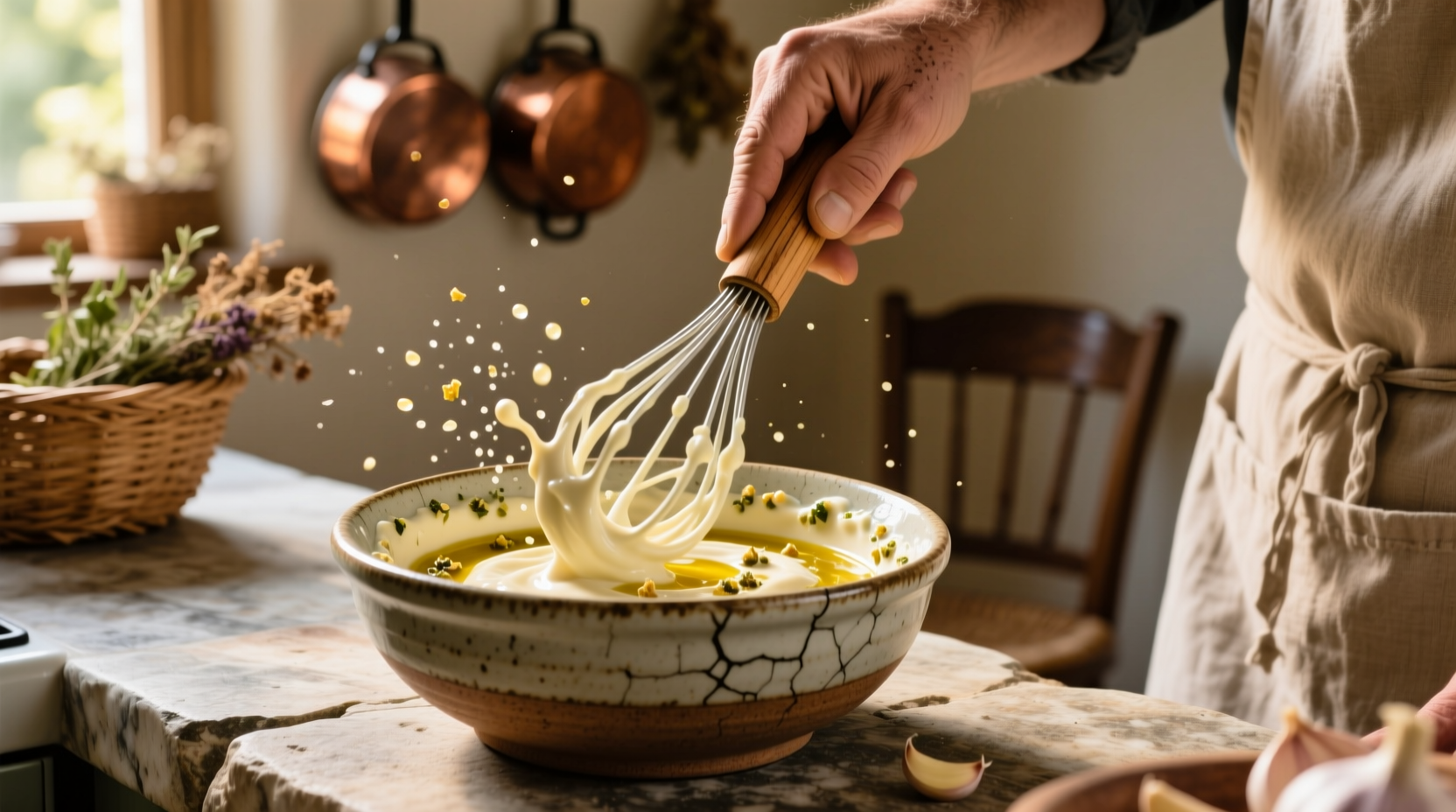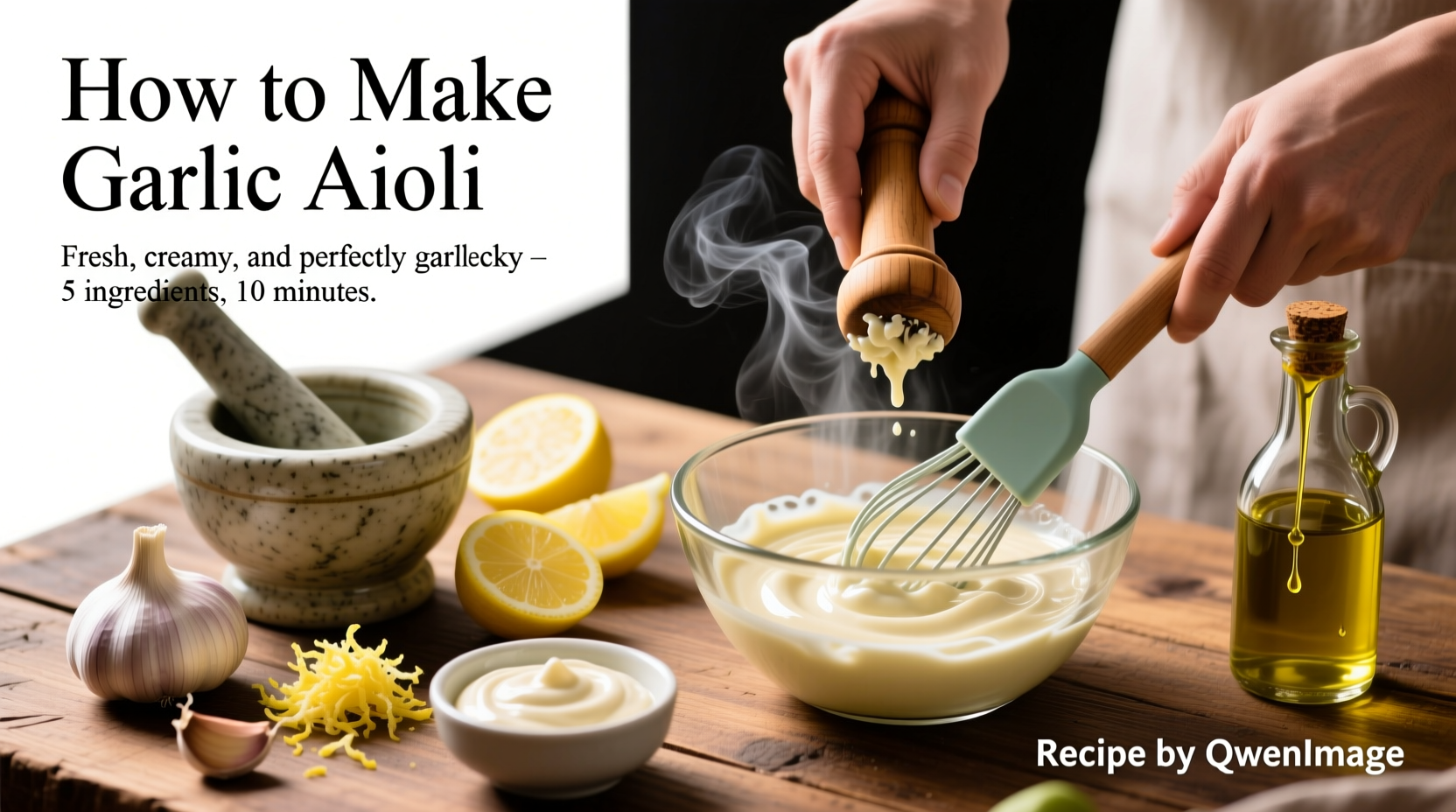Make perfect garlic aioli in 10 minutes with just 6 ingredients: 2 egg yolks, 1 cup extra-virgin olive oil, 3 garlic cloves (minced), 1 tsp lemon juice, 1/2 tsp Dijon mustard, and a pinch of salt. This authentic emulsion technique creates a creamy, flavorful sauce that elevates sandwiches, seafood, and vegetables without artificial additives.
Why This Garlic Aioli Recipe Delivers Restaurant-Quality Results
Creating exceptional garlic aioli isn't just about mixing ingredients—it's understanding the emulsion science that transforms simple components into a luxurious sauce. Unlike store-bought versions loaded with preservatives, homemade aioli offers brighter garlic flavor and cleaner ingredients. The key lies in the slow incorporation of oil, which creates a stable emulsion that won't break. This technique, perfected over centuries in Mediterranean coastal regions, produces a sauce with superior texture and depth of flavor that enhances rather than overwhelms your dishes.
Your Essential Aioli Ingredient Checklist
Quality ingredients make the difference between good and extraordinary aioli. Here's what you'll need with specific recommendations:
- Egg yolks (2 large): Use fresh, preferably pasteurized eggs for safety
- Extra-virgin olive oil (1 cup): Choose a mild, fruity variety—not too peppery
- Fresh garlic (3 cloves): Young garlic provides the best balance of flavor
- Lemon juice (1 tsp): Freshly squeezed for optimal brightness
- Dijon mustard (1/2 tsp): Acts as an emulsifier and adds complexity
- Sea salt (pinch): Enhances all flavors without overpowering
| Ingredient | Substitution | When to Avoid Substitution |
|---|---|---|
| Extra-virgin olive oil | Avocado oil (mild flavor) | When authentic Mediterranean flavor is essential |
| Egg yolks | 1/4 cup aquafaba (for vegan) | When maximum traditional authenticity is required |
| Fresh garlic | 1/4 tsp garlic powder (in emergency) | When fresh garlic is available (powder creates different flavor profile) |
Step-by-Step: Crafting Perfect Garlic Aioli
Preparing Your Ingredients
Mince your garlic finely and let it rest for 5 minutes—this activates the allicin compounds that create that characteristic garlic flavor. Combine the egg yolks, lemon juice, Dijon mustard, and salt in a medium bowl. Whisk until smooth and slightly thickened. This initial mixture creates the emulsion base that will hold your oil.
Building the Emulsion
This is where most home cooks go wrong. Start by adding just 5-6 drops of oil while whisking constantly. Once incorporated, switch to a very slow, steady stream—about 1 teaspoon per minute. Whisk vigorously in a circular motion, ensuring each addition of oil fully incorporates before adding more. After the first 1/4 cup incorporates successfully, you can gradually increase the oil flow.

Troubleshooting Common Issues
If your aioli breaks: Stop adding oil immediately. In a clean bowl, whisk 1 teaspoon of warm water, then slowly whisk in the broken emulsion, drop by drop. This usually rescues it.
If too thick: Add 1/2 teaspoon of warm water and whisk until desired consistency.
If too garlicky: Balance with additional lemon juice (1/4 tsp at a time).
Historical Evolution of Garlic Aioli
Aioli's journey from humble peasant food to gourmet staple reveals fascinating culinary evolution. Originating in Mediterranean coastal regions around the 1st century BCE, early versions combined garlic and olive oil using a mortar and pestle—a technique documented in International Culinary Institute archives. The addition of egg yolks, which created a more stable emulsion, emerged around the 17th century as egg production became more widespread. By the 19th century, aioli had become a centerpiece of Provençal and Catalan cuisine, traditionally served with fish and vegetables. Modern chefs have expanded its applications while preserving the essential garlic-olive oil foundation that defines authentic aioli.
When to Choose Aioli Over Mayonnaise
Understanding context boundaries prevents culinary missteps. Use garlic aioli when:
- Serving Mediterranean-inspired dishes (grilled fish, roasted vegetables)
- Seeking a more complex, aromatic sauce (aioli's garlic notes enhance rather than mask)
- Creating dishes where olive oil's fruitiness complements other ingredients
Avoid substituting aioli for mayonnaise when:
- Preparing delicate sandwiches where strong garlic would overpower
- Creating recipes requiring neutral-flavored binding agent
- Serving to guests with garlic sensitivity or dietary restrictions
Serving Suggestions and Storage Guidelines
For optimal flavor development, let your aioli rest for at least 30 minutes before serving—this allows the garlic compounds to fully integrate. Serve with:
- Grilled artichokes or asparagus
- As a sandwich spread (especially with roasted red peppers)
- With crusty bread for dipping
- As a base for seafood cocktails
Store in an airtight container in the refrigerator for up to 4 days. The garlic flavor will intensify over time, so you may want to adjust initial quantities if making ahead. Never leave aioli at room temperature for more than 2 hours due to the egg content.
Three Flavor Variations to Try
Lemon-Herb Aioli
Add 1 tablespoon finely chopped fresh herbs (parsley, chives, or tarragon) and increase lemon juice to 1.5 teaspoons. Perfect for seafood dishes.
Roasted Garlic Aioli
Substitute raw garlic with 4 cloves of roasted garlic. Creates a sweeter, more mellow flavor ideal for sandwiches.
Spicy Harissa Aioli
Mix in 1 teaspoon harissa paste after emulsion forms. Adds North African heat that complements grilled meats beautifully.











 浙公网安备
33010002000092号
浙公网安备
33010002000092号 浙B2-20120091-4
浙B2-20120091-4